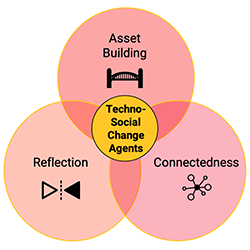
Culturally Responsive Astronomy Lessons
developed by Christine O'DonnellWe developed a framework for creating culturally responsive astronomy curricular activities. Each of the sections below walks through the various lessons in a sample curriculum built using our framework, which is described in more detail this Expert Recommendation (and even more details in this pre-print of an article that's currently under review). This curriculum was developed in partnership with collaborators in Hawaii, and the target audience was junior-senior high school students in Hawaii with possible implementation in a week-long program for female-identifying students. Each section includes attachments in both .docx and .pdf format.
If you have any questions, comments, etc., please contact Christine O'Donnell (christine.a.odon@gmail.com)
Defining the Culturally Responsive Approach
A more complete explanation of the approach is available in the related expert recommendation. Briefly, the goal of these materials is to introduce students to astronomy concepts in a way that (1) values students' existing knowledge and beliefs, (2) guides students to reflect on their positionalities and inequities in society, and (3) fosters a sense of connectedness to each other as peers as well as with their broader communities. These three tenets are summarized in the table below.
|
|
Asset Building: Explicitly incorporates and values learners’ prior knowledge and beliefs into the astronomy content |
|
|
Reflection: Guides learners to identity, question, and assess assumptions and social inequities in their own lives and society at large |
|
|
Connectedness: Fosters relationships between learners and their communities (including peer connections), which (1) creates a sense of accountability to a larger community and (2) guides students to be seen as leaders and thus receive recognition from meaningful others |
By building a curriculum on our culturally responsive approach, we guide students towards being techno-social change agents - that is, students who are empowered to problematize social inequities and develop solutions using their new technical knowledge and skills.
Each lesson has an Opening Activity, main Lesson Activity, and Closing Activity. Next to each activity is an icon that indicates whether it highlights asset-building, reflection, and/or connectedness (often times, an activity will involve more than one of these tenets).
 Introduction
Introduction
The goal of this lesson is to introduce students to the culturally responsive approach, which may be different from their usual science class experiences. As part of this introduction, it is extremely important to have the students (or, as in the curriculum, learners) co-create classroom norms, especially since discussions about identity and power can be sensitive and uncomfortable. However, these discussions are becoming increasingly important and ubiquitous in society and science, and so it's crucial to have students practice these skills in the classroom. Additionally, making sure students feel seen and heard is part of what makes culturally responsive approaches so effective.
If you need additional prompts/ideas for norms and expectations, I developed some resources for an educational developer group that I work with; while these were not designed for the classroom, many of the ideas are transferable.
Furthermore, if you are able/comfortable, please work with members and elders of local Indigenous communities to invite them to participate in these units. Looking at the sky and trying to understand what we see is something that humans have been doing for millennia, and this curriculum admittedly focuses on science's way of understanding the Universe. However, science is not the only way of thinking and knowing about the world around us. If you are able to, perhaps devote an entire class/program session to let members of the local Indigenous community share their thoughts and approaches, and reference/tie in their content with the rest of the content within this curriculum. You can also invite them to participate in the Closing Ceremony (the last lesson) where students (learners) have the opportunity to present their final projects.
Finally, the introduction guides students to explore online resources to learn about the Solar System (specifically, the Earth-Sun system), which will provide a basis for the following lessons


 Modeling the Earth-Sun System
Modeling the Earth-Sun System


